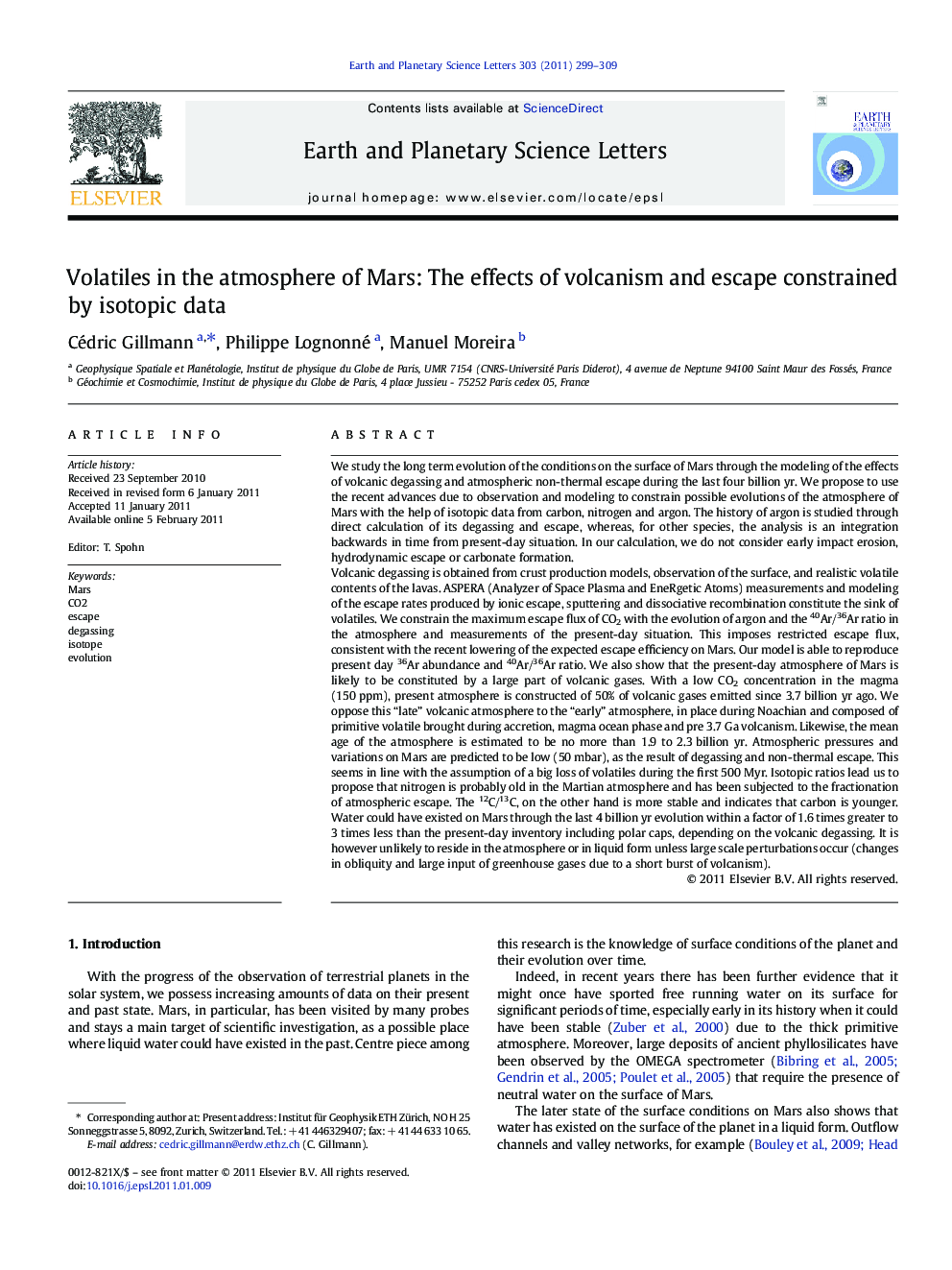| کد مقاله | کد نشریه | سال انتشار | مقاله انگلیسی | نسخه تمام متن |
|---|---|---|---|---|
| 6430744 | 1634833 | 2011 | 11 صفحه PDF | دانلود رایگان |

We study the long term evolution of the conditions on the surface of Mars through the modeling of the effects of volcanic degassing and atmospheric non-thermal escape during the last four billion yr. We propose to use the recent advances due to observation and modeling to constrain possible evolutions of the atmosphere of Mars with the help of isotopic data from carbon, nitrogen and argon. The history of argon is studied through direct calculation of its degassing and escape, whereas, for other species, the analysis is an integration backwards in time from present-day situation. In our calculation, we do not consider early impact erosion, hydrodynamic escape or carbonate formation.Volcanic degassing is obtained from crust production models, observation of the surface, and realistic volatile contents of the lavas. ASPERA (Analyzer of Space Plasma and EneRgetic Atoms) measurements and modeling of the escape rates produced by ionic escape, sputtering and dissociative recombination constitute the sink of volatiles. We constrain the maximum escape flux of CO2 with the evolution of argon and the 40Ar/36Ar ratio in the atmosphere and measurements of the present-day situation. This imposes restricted escape flux, consistent with the recent lowering of the expected escape efficiency on Mars. Our model is able to reproduce present day 36Ar abundance and 40Ar/36Ar ratio. We also show that the present-day atmosphere of Mars is likely to be constituted by a large part of volcanic gases. With a low CO2 concentration in the magma (150Â ppm), present atmosphere is constructed of 50% of volcanic gases emitted since 3.7Â billion yr ago. We oppose this “late” volcanic atmosphere to the “early” atmosphere, in place during Noachian and composed of primitive volatile brought during accretion, magma ocean phase and pre 3.7Â Ga volcanism. Likewise, the mean age of the atmosphere is estimated to be no more than 1.9 to 2.3Â billion yr. Atmospheric pressures and variations on Mars are predicted to be low (50Â mbar), as the result of degassing and non-thermal escape. This seems in line with the assumption of a big loss of volatiles during the first 500Â Myr. Isotopic ratios lead us to propose that nitrogen is probably old in the Martian atmosphere and has been subjected to the fractionation of atmospheric escape. The 12C/13C, on the other hand is more stable and indicates that carbon is younger. Water could have existed on Mars through the last 4Â billion yr evolution within a factor of 1.6 times greater to 3 times less than the present-day inventory including polar caps, depending on the volcanic degassing. It is however unlikely to reside in the atmosphere or in liquid form unless large scale perturbations occur (changes in obliquity and large input of greenhouse gases due to a short burst of volcanism).
Research Highlights⺠Late evolution of Mars is dominated by volcanic degassing as a source of volatiles. ⺠Early evolution (large escape) left the atmosphere depleted but enriched in 13C. ⺠Late escape would have been low with only a moderate effect on CO2 and Ar evolution. ⺠CO2 content of the Martian lavas is likely to stay between 1000 and 150 ppm.
Journal: Earth and Planetary Science Letters - Volume 303, Issues 3â4, 1 March 2011, Pages 299-309